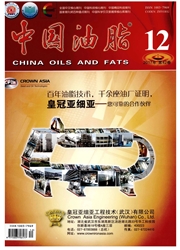

 中文摘要:
中文摘要:
探讨用ω6/ω3多不饱和脂肪酸(PUFA)比例为4∶1的混合植物油部分替代高脂饲料中脂肪对小鼠肝脏脂质代谢的影响。30只6周龄雄性ApoE^(-/-)小鼠随机分为3组:对照组小鼠给予普通饲料,模型组小鼠给予高脂饲料,干预组小鼠给予调整后的高脂饲料并同时以灌胃方式给予ω6/ω3PUFA比例为4∶1的混合植物油。12周后检测小鼠血清和肝脏脂质水平及肝脏中与胆固醇代谢相关基因的表达变化。结果表明:与模型组相比,干预组小鼠血清TC、TG、LDL-C和ox-LDL含量分别极显著(P〈0.01)降低了53.0%、64.6%、46.8%和25.0%;肝脏组织中ABCA1、ABCG1、ACAT-1、LAL的mRNA表达较模型组分别提高了17.0%(P〈0.01)、16.0%(P〉0.05)、24.0%(P〈0.05)和21.0%(P〉0.05),而CD36、MSR-1和LOX-1的mRNA表达分别极显著(P〈0.01)下调了43.0%、35.0%和40.0%。结果显示,以ω6/ω3 PUFA比例为4∶1的混合植物油部分替代高脂饲料中脂肪有助于降低血清脂质水平,这可能与PUFA抑制胆固醇吸收、增加胆固醇外排和酯化有关。
 英文摘要:
英文摘要:
The effect of partial replacement of fat in high - fat diet by mixed vegetable oils containing ω6/ω3 polyunsaturated fatty acids(PUFA) in a ratio of 4:1 on hepatic lipid metabolism in mice was investigated. Thirty sixweeks old male ApoE-/- mice were randomly divided into three groups: control group taking normal diet, model group taking high -fat diet, and intervention group taking the adjusted high - fat diet and administrated with mixed vegetable oils containing to6/to3 PUFA in a ratio of 4: 1. After feeding for 12 weeks, the lipids levels in serum and hepatic, and the mRNA expression of genes in-volved in cholesterol metabolism in liver of mice were measured. The results showed that compared with model group, the levels of TC, TG, LDL - C and ox- LDL in serum of mice in intervention group significantly (P 〈 0. 01 ) decreased by 53.0%, 64.6%, 46.8% and 25.0%, respec-tively. Compared with model group, the mRNA expressions of ABCA1, ABCG1, ACAT - 1 and LAL in liver tissue of mice in intervention group increased by 17.0% (P 〈0.01 ), 16.0% (P 〉0.05) ,24.0% (P 〈0.05), and 21.0% (P 〉0.05), respectively. However, compared with model group, the mRNA expressions of CD36, MSR - 1 and LOX - 1 significantly (P 〈0.01 ) decreased by 43.0% , 35.0% and 40.0%, respectively. These data suggested that partial replacement of fat in high - fat diet by mixed vegetable oils containing ω6/ω3 PUFA in a ratio of 4:1 was beneficial for reducing serum lipid levels, which might be related to PUFA inhibiting influx of cholesterol and increasing efflux and esterification of cholesterol.
 同期刊论文项目
同期刊论文项目
 同项目期刊论文
同项目期刊论文
 期刊信息
期刊信息
